Email is the most used communication channel across the globe. But, even then, if you look at an email from a decade ago and compare it with one from today, you’ll notice that emails haven’t changed much. While all the other communication channels have evolved at speed, email has been the odd boomer amongst the Millenials.
Experts were even raising alarms that the email had gone dead or would work for sure in a decade!
Fast Forward to 2019. This year, Google released AMP for email for the Gmail web app. This release could include AMP components like forms, carousels, accordions, and more inside the email.
Creating a dynamic email experience became easy. AMP emails started making CTA buttons, and redirects blush with the prospect of all the actions now possible right inside emails. One could interact and act inside an email with an AMP email. Now, let that idea sink in!
AMP email has been a great conversation starter in email and marketing communities.
So, in this guide, we will unpack everything about AMP email for you from its component to use cases. We will also discuss its impact on email marketing and how you can use the interactivity and engagement it offers to send awesome emails.
Table of contents
Is AMP for email going to transform the marketing landscape?
-
- 1. Which email marketing platform can I use to send AMP emails?
- 2. Which email clients support AMP for Email?
- 3. Who is using AMP for email?
- 4. What will my customers see if they don't use an AMP-supported email client?
- 5. How do I preview and test AMP emails?
- 6. Are there any pre-made AMP email templates available?
What is AMP email?
AMP email is a framework created by Google to enable email marketers to create and send interactive emails that allow people to fill out forms, purchase products, book meetings, and more without leaving their inboxes.
Is AMP for email going to transform the marketing landscape?
AMP broke the general thumb rules of email marketing and replaced them with a fresh and dynamic alternative. As a result, AMP emails have been a popular topic for quite some time now, but marketers have different opinions about the benefits and drawbacks of AMP Emails.
So for a broader look at AMP for Emails, we’ve gathered below insightful comments from the email marketing community.
My stance hasn’t changed: I would like to see better support for AMP and greater ESP adoption before using it in production. Right now I’m still in “fun to play with” mode with it.
- Elle Wilson, Developer & Consultant, ElleGetsItDone
It’s been interesting to observe the sentiment toward AMP for Email evolve over the past 18 months as more ESPs begin supporting it and prominent thought leaders express their support for it. Naysayers are beginning to soften! The ability to add interactivity to email is incredibly cool, so it’s only natural that folks are focused on that aspect of the technology.
But honestly, what excites me most is that AMP for email could be a step towards standardization among email clients. Because AMP is a unique mime type, it renders consistently across email clients that support it. You don’t have to worry about broken layouts! So even if you create emails that are not interactive, you can rest assured it’s going to look terrific everywhere AMP for email is supported when you use the AMP mime type.
- Jen Capstraw, President & Co-Founder, Women of Email
Key benefits of AMP in email marketing
Let’s cut the chase and look at the features that make AMP for email a beneficial tool for email marketing.
Dynamic content
AMP for email comes with a functionality that enables your email to be updated when there’s new information. This way, critical and sensitive information can be kept up to date.
Provides a website-like experience within an email
AMP for email provides you a rich inbox experience that enables website-like functionalities within an email - you can perform tasks like submitting multi-step forms, adding items to carts, etc., all right inside your email.
More engagement
AMP for email contains dynamic content and a rich inbox experience with the help of interactive and actionable elements. This itself makes a user want to explore an interactive email more. This way, you can curate better emails for marketing.
Interactivity
The longer a potential customer contemplates, the lesser the chances of conversion. With AMP email, you can reduce this time by giving your subscribers an option to finish the transaction within an email. This helps in generating leads and converting them into customers.
💡 Related read: A comprehensive guide to create interactive emails
Secure technology
Emails are more secure with AMP as it restricts 3rd party providers from utilizing your data. This means zero intrusions.
AMP emails vs HTML emails
AMP emails are an upgraded version of HTML emails and offer more interactivity and functionality inside an email. Not only this but there are many other ways, both technical and utility-wise, in which AMP email differs from the standard HTML emails.
| HTML email | AMP email |
|---|---|
| HTML emails are coded in the traditional HTML language. They are built as more sophisticated emails than text emails. | AMP emails are also coded in HTML but must identify themselves with specified declarations and the use of predefined elements. For e.g. AMP emails must include ‘⚡4email’ or ‘amp4email’ in the HTML tag. A CSS boilerplate to initially hide the content until AMP is loaded |
| HTML emails contain text, images, and URLs. CTAs are usually built as buttons that take the user to required landing pages. | AMP emails contain in-mail forms, calendars, carts, carousel, and other interactive elements in addition to all the UI capabilities of an HTML email |
| A typical HTML user journey contains email, clicking buttons, and then reaching a landing page. The user experience has friction and is cluttered. | It enables users to perform tasks and CTAs with fewer steps and zero redirects. This simplifies and improves the user experience. |
| Boasts of ROI more than any other marketing channels | Boasts of ~3X ROI over HTML emails |
| Allows in-frame ads and 3rd party intrusions inside the email. Whitelisting, DMARC, DKIM, and SPF are not mandatory to send emails. | An Email provider allows AMP only after placing strong security checks and only uses vetted AMP scripts. Thus, DMARC, DKIM, and SPF are required for AMP approval. These protocols safeguard against phishing, spoofing, and other fraudulent activities. |
Here's an example of how AMP email with its in-mail form simplifies an email survey as compared to a typical HTML email built with CTA and a landing page as part of the campaign.
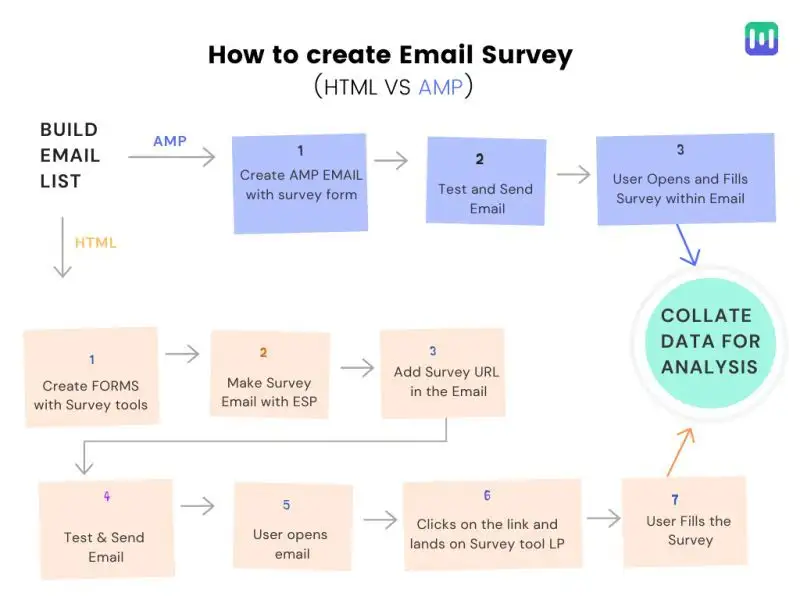
AMP email use cases and examples
AMP emails are highly beneficial for many industries and businesses. Some of the important use cases and examples of AMP emails are as follows:
1. AMP email forms
AMP emails can be used to generate and nurture leads more effectively with the help of interactivity. Because of higher engagement and interactivity, the conversion rate of lead generation campaigns is higher than standard emails.
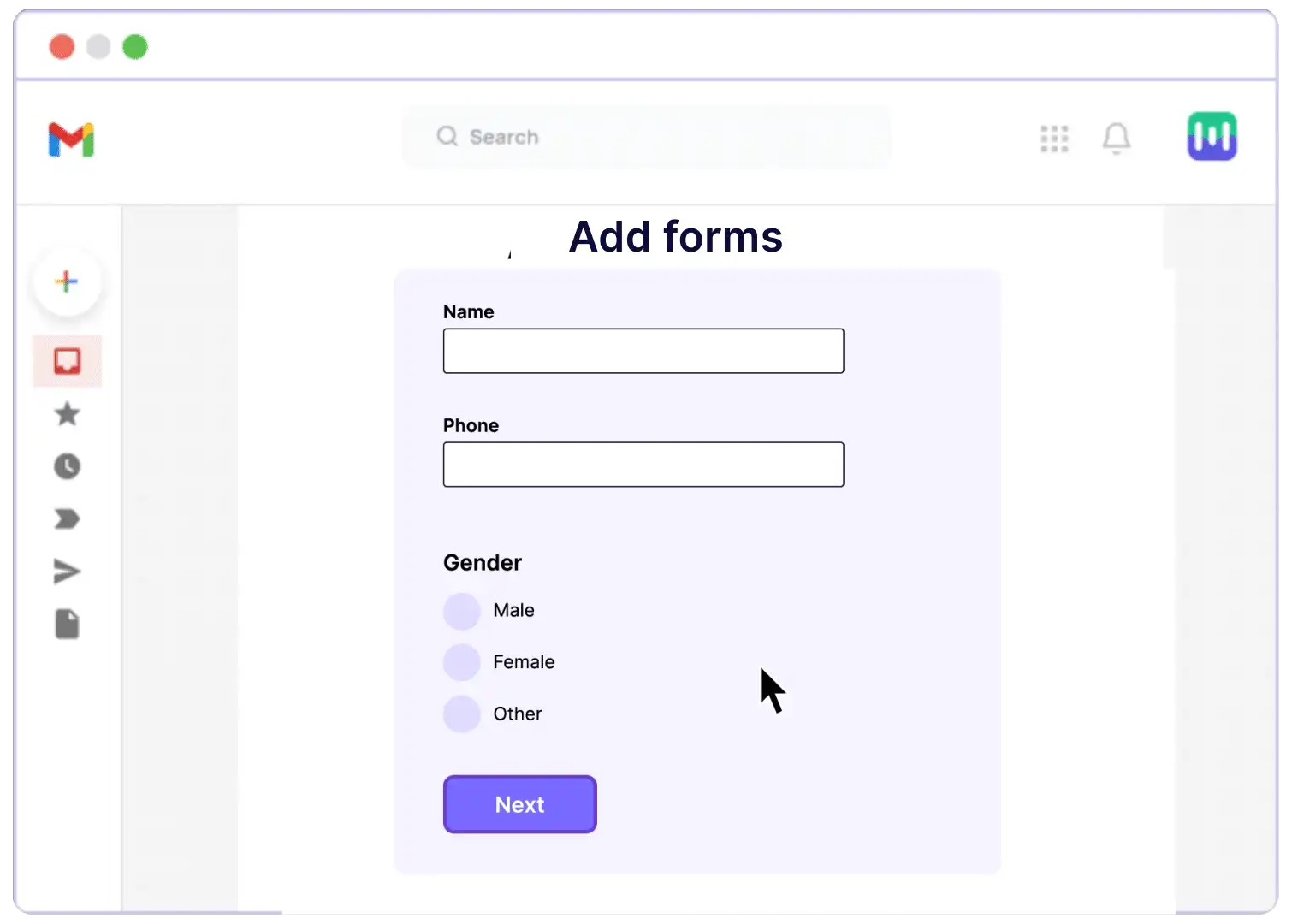
2. AMP email survey
Interactive emails can be used to create single and multi-step forms inside emails and conduct surveys. As the respondents’ responses are filled in, the response rate improves drastically. One can conduct any survey and data collection process with interactive emails. Market research HR Surveys are typical examples of such a use case.
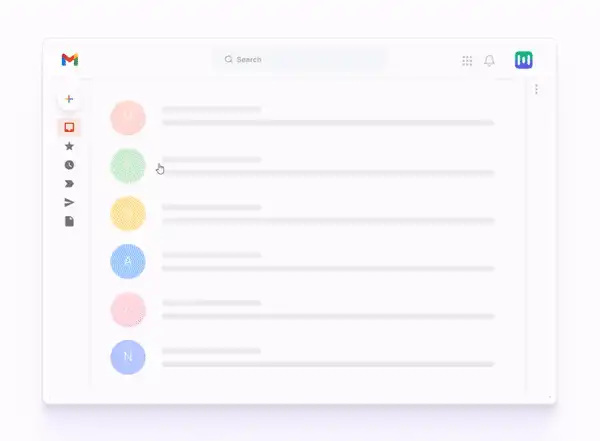
3. NPS and CSAT
Customer feedback, including NPS surveys and CSAT questionnaires, can be easily created inside emails with AMP for emails.
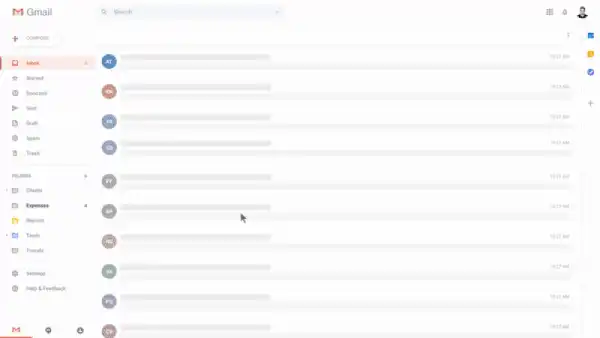
4. Interactive calendars
With native interactive calendars and integrations with widgets like Calendly and Zoom, users can book meetings right inside the email. Getting meetings booked for product demos, conducting a webinar or conference registrations, and booking customer support calls and appointments can now be done with lesser friction and zero redirects to the event or calendar management website.
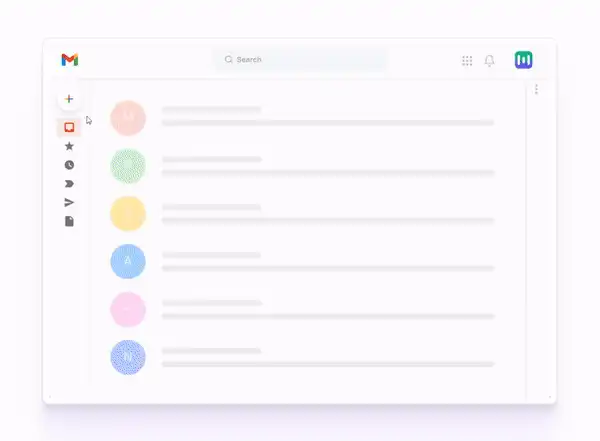
5. Recovering abandoned carts
E-commerce businesses can improve their cart recovery rate with interactive promotional email campaigns. With AMP emails, instead of sending just images of the new collection or better offers, businesses can include a checkout option in the email.
Even though payments cannot be made inside emails, this reduces the distance between the consumer and the payment gateway. This is a game-changer for e-commerce.
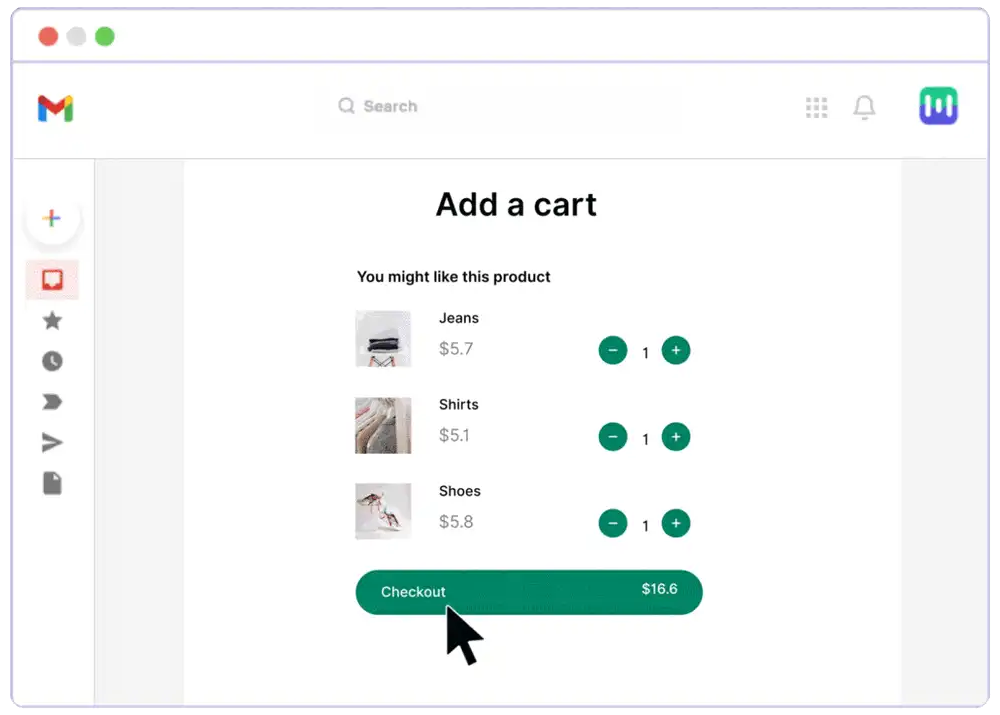
💡 Related read: A beginner’s guide to AMP emails for e-commerce
6. Interactive calculators
Fintechs, Insurance companies, and others can send calculators for premium, SIP, and other utilities inside emails, thus bringing customers closer to making an easy decision. Since one can see quotes and calculations inside the email, it can motivate an individual to buy in less time.
Compare this with traditional mails, where one has to click on the CTA and then enter variables in the calculator on another webpage after signups. Friction and multiplicity of steps are surely a customer deflector.
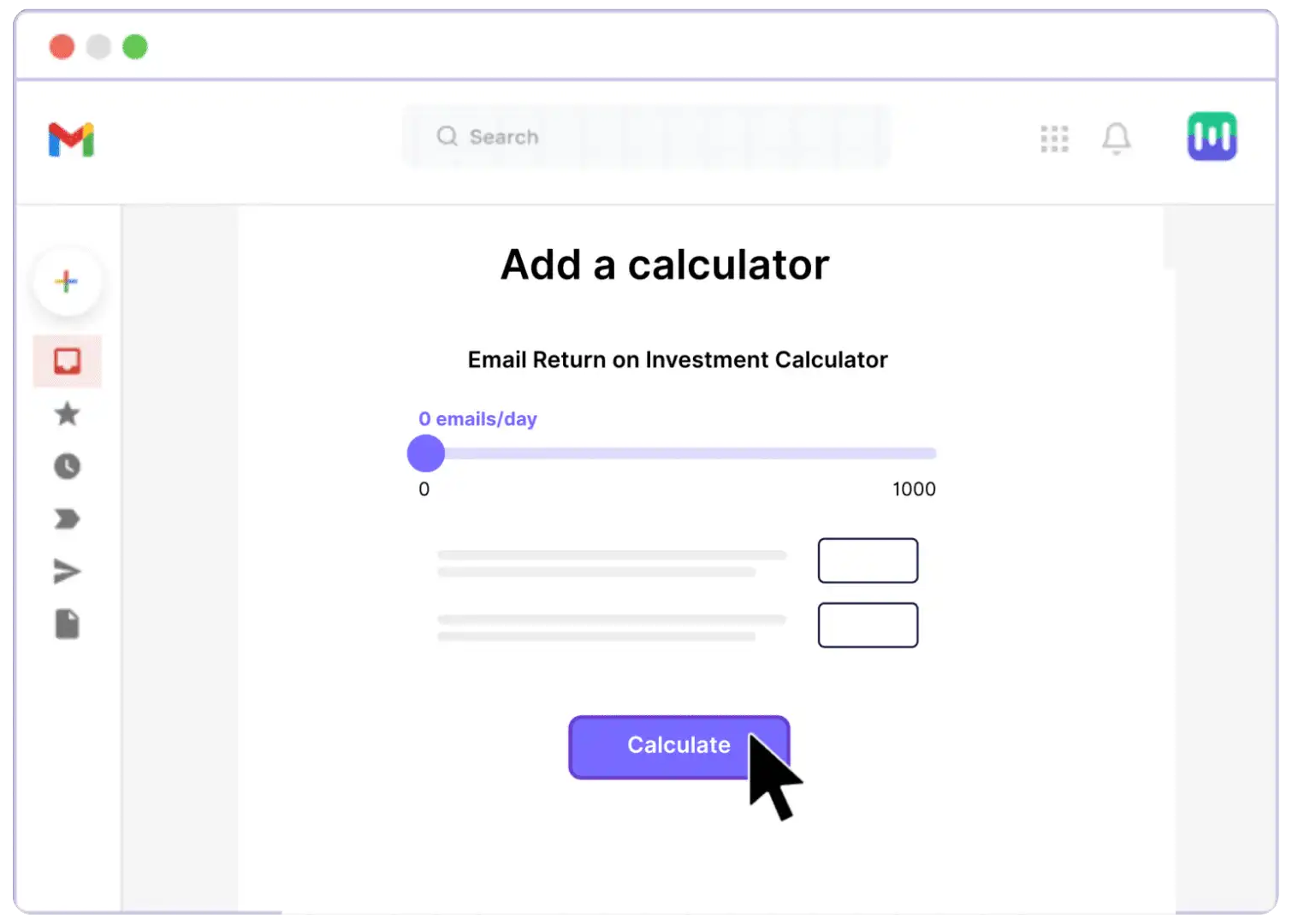
7. Quizzes
Engage or assess your subscribers with interactive quizzes that can be sent and played within an email. This can be used to spark engagement or score your students' performance.

8. Rewards with wheel spinner
Give your subscribers exciting rewards with gamified email experience. Send a customized spin-the-wheel widget inside the email to gift your loyal customers.

8. Business model and industry-specific use cases
AMP emails can be customized to improve marketing, sales, and communication processes across business models and industry verticals. A few examples are presented below:
B2B
Business-to-Business companies focus on selling products and services to other companies. Using AMP-powered emails gives B2B companies a way to stand out in their leads’ inboxes and remove some sales funnel barriers. For example, B2B companies can use AMP emails to reach out and engage with their customers. With AMP Forms, they can increase their demo bookings, collect feedback, and much more.
💡 Related read: Your one-stop guide for B2B email marketing to drive sales
B2C
Business-to-consumer companies focus on selling products directly to customers. Using AMP emails gives these companies a way to increase sales more effectively. Promotional emails become interactive and more engaging. This can result in more sales, upsells, and cross-sells, with product recommendations being doled out in carousels and through other email interactive elements.
💡 Related read: A comprehensive guide to B2C email marketing
SaaS
Software as a service provides software or an application over the Internet as a service, usually licensed on a subscription basis. AMP emails can be used in the SaaS business to help improve engagement, get more demo bookings, improve onboarding experience, customer retention, and overall newsletter reading experience.
Travel industry
The travel industry can use AMP email by letting the customers book and access their tickets right inside the email. It can also use the dynamic feature of AMP emails to update prices and booking availability data inside the emails as soon as it is changed in real life. For example, airfares are very dynamic and surge or deflate now and then. This change can be captured in real-time in dynamic emails.
BFSI
For the Finance industry, AMP email can provide a structure inside an email to compute the advance subtleties and utility parameters by simply rendering different calculations like premiums, investments, interest, loan amount, and loan duration based on user inputs inside emails. It can similarly empower a few other accounting parameters right inside the email.
These are just a few of the popular and beneficial use cases. There are other industries and verticals where AMP email has several use cases and is useful for high conversions.
💡 Related read: A deep dive into AMP email use cases
Performance report - How well do AMP emails convert?
Are you curious if AMP emails convert better than Static HTML emails?
Well, at Mailmodo, we conducted real-time performance tests to find this and discover the effect of AMP for email on conversions. In most of our performance tests, we found that AMP emails convert by ~3X more than the traditional HTML emails.
The following are some of our case studies where we consistently discovered this conversion trend.
257% increase in survey response
What we did: We replaced the existing customer feedback mechanism for our client Razorpay, India’s first full-stack financial solutions provider, with interactive in-mail customer feedback forms.
What changed:
The entire survey flow was depicted inside the email body using AMP emails.
A dynamic multi-step AMP questionnaire through which the user could send feedback inside an email itself was sent out through Mailmodo.
Users didn’t have to visit any landing page to access and fill out the survey. The survey was now more accessible being inside the email.
Form submission rate increased by 370%
What we did: We collaborated with Talent500, a talent-first platform, to replace job application quiz links in email with dynamic job application forms inside emails.
What changed:
The entire job application form was available inside the AMP email, ready to be filled.
Multi-step forms were created to collect relevant information from the candidates.
The candidates could select and submit answers within their emails without being directed to another page.
NPS response rate increased by 833%
What we did: Working with our client BlueStone, a leading jewelry & lifestyle company, we replaced their NPS Survey email and landing page combination with an interactive email that contained rating questions and feedback forms.
What changed:
Interactive AMP emails contained the NPS questionnaire within the inbox and required minimum clicks to submit responses.
Users didn’t get redirected to another webpage for survey filling.
Create survey forms without any 3rd party tools.
The results of these case studies clearly showed that interactive AMP emails could change email marketing and set a new standard for conversion and engagement metrics.
Now that we have seen how well AMP emails perform, you might want to know how to start sending such emails. There are two alternatives to this, you can either follow the steps mentioned below to do this or as mentioned in the section, you can use Mailmodo to get all of this sorted for you.
So without further ado, let’s see how we can start using AMP emails.
How to create AMP emails?
To get started with AMP emails, you need to fulfill specific requirements before creating and sending your first AMP Emails. First, let’s look at the significant hurdles you need to cross to start using AMP emails.
Step 1: Sender email authentication and whitelisting
AMP emails have to undergo DKIM, DMARC, and SPF security protocols and certifications to ensure the sender's authenticity.
Registering with email clients
One of the essential steps to sending AMP Emails is registering with your email client to whitelist your domain. Whitelisting your domain means showing that your email is safe to send to subscribers.
As of now, only the below three email clients support sending of AMP emails:
Step 2: Building the AMP email
The primary requirement to send AMP emails is to build them. This can be done by coding since major ESPs do not support AMP.
The inclusion of the interactive AMP elements is possible only with specific AMP-enabled components.
The important components of AMP for email are as follows:
1. Media components: AMP’s media components contain attributes that allow you to add images and gifs to AMP emails.
2. Dynamic components: Dynamic components of AMP contain attributes like Amp-form, Amp-selector, Amp-bind, Amp-state, and Amp-list that help add dynamic elements and interactivity to your email.
3. AMP layout components: The layout components of AMP contain attributes that allow you to add accordion, carousels, layouts, links, etc., to your AMP email.
| Component type | AMP email |
|---|---|
| Media components | Amp-img. Amp-anim |
| Dynamic components | Amp-form, Amp-selector, Amp-bind, Amp-image-lightbox, Amp-state, Amp-mustache, Amp-list |
| Layout components | Amp-layout, Amp-accordion, Amp-carousel, Amp-fit-text, Amp-sidebar |
💡 Related read: A complete guide to AMP email components
Step 3: Debugging and previewing AMP emails
Once you have built your AMP emails, you need to debug and preview them to render them correctly. Here’s a very brief description of these processes:
Debugging
Debugging banners help developers determine why and which parts of their emails aren’t displaying as AMP emails. Whitelisting the sender’s email address is essential to enable the debugging banner.
Previewing & validating
The preview option shows how your email will look in the recipients’ inboxes. You can Preview the AMP page just as you usually would preview any other static HTML site. There’s no build step or preprocessing required.
Step 4: Testing your AMP email
Testing your AMP emails is essential for verifying your email content before sending it. You can use the following method to test your email for Gmail and G-Suite:
Gmail’s AMP playground helps you draft, preview, and send your AMP emails to your account for testing
In your Gmail account’s developers settings, you can whitelist an email address through which you can send AMP emails for testing.
💡 Related read: How to preview and test an AMP email?
Step 5: Validate AMP emails
AMP emails depend on the AMP Js library to enable rich interactive and dynamic experiences for readers. For this reason, email providers require your messages to be validated. Valid AMP markup guarantees emails are safe and exceed user experience standards.
After previewing, testing, and validating your AMP emails, the next step is to send them.
💡 Related read: How to validate your AMP emails?
Step 6: Sending AMP emails
You have to add a new MIME part to the MIME tree to start sending AMP emails. What this does is that if your email is sent to a client that has AMP for Email support, it will be displayed as it is. Else, the email client will display the HTML or plain text fallback version.
💡 Related read: Learn more about adding new MIME for AMP emails here
Once you cross all these steps, you will be able to send your first AMP emails.
However, there is a much simpler way to send AMP emails. You can skip all this hassle and hustle if you use Mailmodo, an email marketing tool specially built to allow marketers to create and send AMP emails without a sweat.
Mailmodo provides you with a no-code AMP email builder, a robust email deliverability engine, a visual journey builder, and an all-encompassing email analytics dashboard, a handy contact manager, and so much more.

How to send hassle-free AMP emails using Mailmodo?
Here is a step-by-step breakdown of sending AMP emails using Mailmodo
Step 1: The first step is to register with Mailmodo. Signing up on Mailmodo
Step 2: Configure your sender addresses and apply for whitelisting by filling in a simple form.
Step 3: Choose an interactive AMP template from the numerous pre-existing ones that suit your use case. You can even create a new template from scratch using Mailmodo’s drag-and-drop template editor. Then, customize your template with the editor and previewer. No coding is required.
Step 4: Add your contacts list and start sending out interactive AMP emails to your clients, leads, prospects, subscribers, users, and stakeholders.
Limitations of AMP in email marketing
Although it provides various advantages for marketers, there are a few challenges of using AMP emails. Some of them are listed below:
1. It’s a new technology
An AMP email message is embedded into the email as a new MIME part, in addition to the existing HTML and plaintext parts. To do this, marketers must write codes as per the specifications laid down in the AMP project. Hence, people are reluctant to use it.
How we are overcoming this limitation?
We have created a coding-free, drag-and-drop AMP email editor in Mailmodo to help you design and create your interactive emails. Before sending them out in a campaign, you can even preview and test your emails, both the AMP and HTML fallback version side-by-side.
2. AMP has limited email client support
Many ESPs are not compatible with AMP. Hence, the deployment of AMP-powered emails is not possible. However, as of now, Gmail, Yahoo Mail, and Mail.ru support it.
How we are overcoming this limitation?
If you send an email to a user who uses an email client that has not extended support to AMP for emails, the user sees the HTML fallback version of the email. The best part is that this fallback version is automatically created as you create the AMP email in Mailmodo.
And yes, you can make changes even to this HTML email with the drag-and-drop editor.
Savvy, right?
3. Difficulty in gauging email performance
Elements such as CTR’s (click-through rates) and other conventional email metrics are difficult to measure and track in AMP-powered emails.
How we are overcoming this limitation?
This isn’t a limitation any more. Mailmodo has a one-stop dashboard covering all the email analytics to help you deliver your email campaigns with confidence and validated learnings. The cherry on the top is the feature to see who and how many viewed your AMP and HTML versions of emails separately. Talk of converting a limitation into a superpower!
4. Post-deployment updates can be misleading
Post-deployment update of the email, i.e., changes in the AMP email content even after hitting the send button, is one of the unique features of AMP emails. However, this may confuse the subscriber, leading to trust issues if the subscriber is not aware of AMP emails.
How we are overcoming this limitation?
This is a user behavior issue, and as such, there isn’t much that we can do at the product end to resolve the issue.
But still, there are things we are doing to get this into the backseat as soon as possible.
First, we are creating ‘awareness’ about AMP email. We churn out content, guides, tutorials, social media posts, podcasts, and webinars to tackle this issue head-on. What’s more, the entire email community is enthused with this idea, and today we know how fast ideas travel.
So it’s just days before this limitation vanishes, and AMP for email becomes a household name for email.
Myths and myth-busting about AMP for emails
As soon as AMP for emails was rolled out, social media tweeted and posted with chatter on this genie’s actual and potential superpowers. But unfortunately, various myths started circulating among marketers based on various conjectures and misunderstandings of the concept and technology of AMP emails.
So, here are the common myths that our team at Mailmodo encountered and our attempt to clarify them.
Myth #1: AMP can allow users to collect payment inside the email.
Fact: No, you cannot.
The payment gateway has to stick to standard compliances to maintain its security and prevent fraud and security breaches. You can read about payment security protocols and standards here.
However, Mailmodo can help you cut the number of steps between your user’s decision to buy and the actual payment. You can collect product information inside the email, and with the help of deep linking, you can redirect the user to the final checkout stage.
In addition, we are developing an e-commerce feature to help marketplaces and suppliers improve their sales. If you want to be notified of this feature, do sign up for our newsletter.
Myth #2: AMP can be used to stream videos inside emails
Fact: We wish we could.
Unfortunately, we cannot stream videos inside AMP emails. A few email clients support HTML5 video in an email, specifically Apple Mail, iOS 10, and the Samsung email client. However, the idea that you can play a video in an email just because it is interactive is not true.
As an alternative for this, GIFs can be inserted inside emails and work as well. The other alternative is to add your Youtube or video URL inside the email. What AMP emails can do better, in this case, is to combine these already existent features like inserting GIFs inside emails with interactive elements like forms, calendars, and carts to send an email in motion to your users.
The future is dynamic
AMP for email can become a widely adopted standard for emails. The entire email marketing community eagerly looks at how AMP emails make their way into businesses and users’ inboxes. As the fingers remain crossed, we would like to invite you to look at interactive AMP emails for yourselves.
You can read our AMP email example guide to get inspiration and ideas on how to ad interactivity to your emails.
So are you ready for a test drive to AMPlify your emails?
AMP email FAQs
1. Which email marketing platform can I use to send AMP emails?
You can use Mailmodo to create, test, and send interactive AMP emails. You can try Mailmodo for 21 days for free and upgrade when you see fit. Our pricing plan starts at $49/month.
2. Which email clients support AMP for Email?
For now, Gmail, Yahoo, Mail.ru, and FairEmail are the email clients supporting AMP.
3. Who is using AMP for email?
Brands like Razorpay, Ecwid, and Indian Express use interactive emails to grow their business revenue.
4. What will my customers see if they don't use an AMP-supported email client?
You can create a fallback HTML email for your customers to see when they use an email client that does not support AMP. You can do this easily using Mailmodo's AMP email builder.
5. How do I preview and test AMP emails?
You can preview and test your AMP emails using Mailmodo's email marketing platform. Other than this, you can use AMP playground to validate your email.
6. Are there any pre-made AMP email templates available?
Yes. We offer 200+ free templates that you can use to send interactive emails instantly without any tech and design support.
What you should do next
Hey there, thanks for reading till the end. Here are 3 ways we can help you grow your business:
Talk to an email expert. Need someone to take your email marketing to the next level? Mailmodo’s experts are here for you. Schedule a 30-minute email consultation. Don’t worry, it’s on the house. Book a meet here.
Send emails that bring higher conversions. Mailmodo is an ESP that helps you to create and send app-like interactive emails with forms, carts, calendars, games, and other widgets for higher conversions. Get started for free.
Get smarter with our email resources. Explore all our knowledge base here and learn about email marketing, marketing strategies, best practices, growth hacks, case studies, templates, and more. Access guides here.


